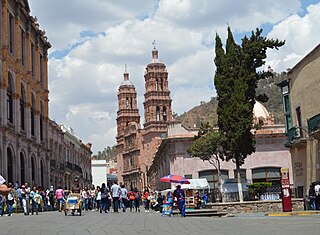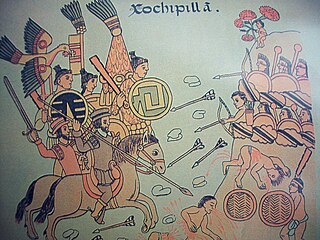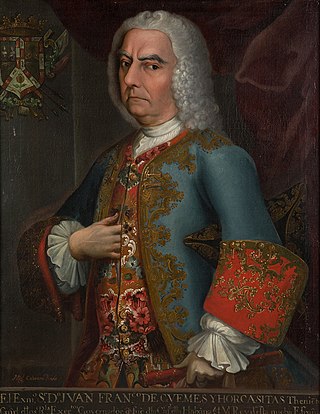Related Research Articles
The Price Revolution, sometimes known as the Spanish Price Revolution, was a series of economic events that occurred between the second half of the 15th century and the first half of the 17th century, and most specifically linked to the high rate of inflation that occurred during this period across Western Europe. Prices rose on average roughly sixfold over 150 years. This level of inflation amounts to 1.2% per year compounded, a relatively low inflation rate for modern-day standards, but rather high given the monetary policy in place in the 16th century.

Santa Fe de Nuevo México was a province of the Spanish Empire and New Spain, and later a territory of independent Mexico. The first capital was San Juan de los Caballeros from 1598 until 1610, and from 1610 onward the capital was La Villa Real de la Santa Fe de San Francisco de Asís.

Zacatecas is the principal city within the municipality in Mexico of the same name, and the capital and the largest city of the state of Zacatecas. Located in north-central Mexico, the city had its start as a Spanish mining camp in the mid-16th century. Native Americans had already known about the area's rich deposits of silver and other minerals. Due to the wealth that the mines provided, Zacatecas quickly became one of the most important mining cities in New Spain. The area saw battles during the turbulent 19th century, but the next major event was the Battle of Zacatecas during the Mexican Revolution when Francisco Villa captured the town, an event still celebrated every anniversary. Today, the colonial part of the city is a World Heritage Site, due to the Baroque and other structures built during its mining days. Mining still remains an important industry. The name Zacatecas is derived from the Zacateco people and has its roots in Nahuatl. The name means "people of the grasslands".

Diego Velázquez de Cuéllar was a Spanish conquistador and the first governor of Cuba. In 1511 he led the successful conquest and colonization of Cuba. As the first governor of the island, he established several municipalities that remain important to this day and positioned Cuba as a center of trade and a staging point for expeditions of conquest elsewhere. From Cuba, he chartered important expeditions that led to the Spanish discovery and conquest of the Aztec Empire.
The Tlaxcalans, or Tlaxcaltecs, are a Nahua people who live in the Mexican state of Tlaxcala.

The Mixtón War (1540-1542) was a rebellion by the Caxcan people of northwestern Mexico against the Spanish conquerors. The war was named after Mixtón, a hill in Zacatecas which served as an Indigenous stronghold.

Juan Francisco de Güemes y Horcasitas was a Spanish general, governor of Havana, captain general of Cuba, and viceroy of New Spain.

Juan Pardo was a Spanish explorer who was active in the later half of the sixteenth century. He led a Spanish expedition from the Atlantic coast through what is now North and South Carolina and into eastern Tennessee on the orders of Pedro Menéndez de Avilés, in an attempt to find an inland route to a silver-producing town in Mexico.
Cristóbal de Oñate was a Spanish Basque explorer, conquistador and colonial official in New Spain. He is considered the founder of the contemporary city of Guadalajara in 1531, as well as other places in Nueva Galicia.

Luis de Carvajal was governor of the Spanish province of Nuevo León in present-day Mexico, slave dealer, and the first Spanish subject known to have entered Texas from Mexico across the lower Rio Grande.

Alberto del Canto, formally Alberto Vieira do Canto, was a noble and military Portuguese conquistador who explored the north of Mexico, where he was the founder of several cities.

Zacatecas ( ), officially the Free and Sovereign State of Zacatecas, is one of the 31 states of Mexico. It is divided into 58 municipalities and its capital city is Zacatecas.

The myth of the Seven Cities of Gold, also known as the Seven Cities of Cíbola, was popular in the 16th century and later featured in several works of popular culture. According to legend, the seven cities of gold referred to Aztec mythology revolving around the Pueblos of the Spanish Nuevo México, today's New Mexico and Southwestern United States.
Doña Isabel de Tolosa Cortés de Moctezuma, was a wealthy New Spanish heiress and the wife of conqueror and explorer Don Juan de Oñate who led an expedition in 1598 and founded the first Spanish settlement in what is now the state of New Mexico. She was the granddaughter of Spanish explorer and conquistador Hernán Cortés, and the great-granddaughter of Aztec Emperor Moctezuma II.

José de la Borda was a Spaniard who migrated to New Spain in the 18th century, amassing a great fortune in mines in Taxco and Zacatecas in Mexico. At one point, he was the richest man in Mexico. He is best remembered today through several architectural works that he sponsored, the most monumental being the Santa Prisca Church in Taxco
Juan de Tolosa was a Spanish Basque conquistador. He discovered rich silver deposits near the present day city of Zacatecas, Mexico, in 1546.

Colonial Argentina is designated as the period of the History of Argentina when it was an overseas territory of the Spanish Empire. It begins in the Precolumbian age of the indigenous peoples of Argentina, with the arrival of the first Spanish conqueror.

Traditional metal working in Mexico dates from the Mesoamerican period with metals such as gold, silver and copper. Other metals were mined and worked starting in the colonial period. The working of gold and silver, especially for jewelry, initially declined after the Spanish conquest of the Aztec Empire. However, during the colonial period, the working of metals rose again and took on much of the character traditional goods still have. Today, important metal products include those from silver, gold, copper, iron, tin and more made into jewelry, household objects, furniture, pots, decorative objects, toys and more. Important metal working centers include Taxco for silver, Santa Clara del Cobre for copper, Celaya for tin and Zacatecas for wrought iron.

Mazapil is a municipality in the Mexican state of Zacatecas and the state's largest municipality by area. The Peñasquito mine, Mexico's largest gold mine, is located in this sparsely populated municipality.
Mazapil is a locality in the Mexican state of Zacatecas. It serves as the municipal seat of the eponymous Mazapil Municipality.
References
- ↑ A. Levin Rojo, Danna (1997). Return to Aztlan: Indians, Spaniards, and the Invention of Nuevo México. ISBN 978-0806144344.